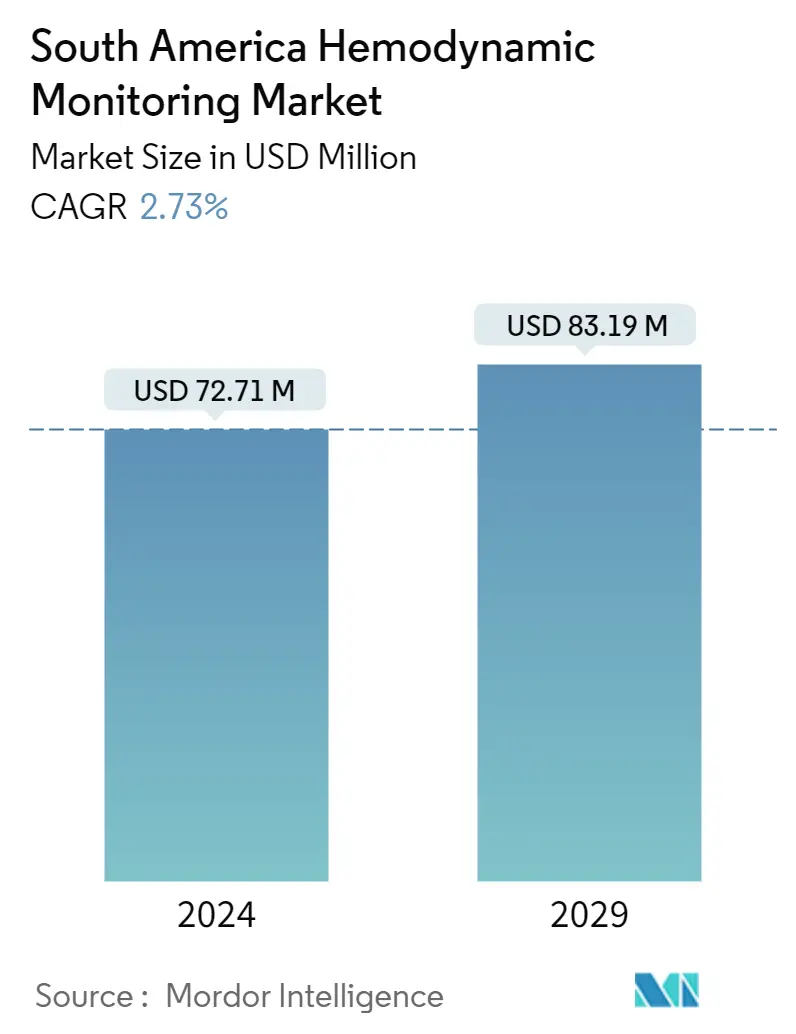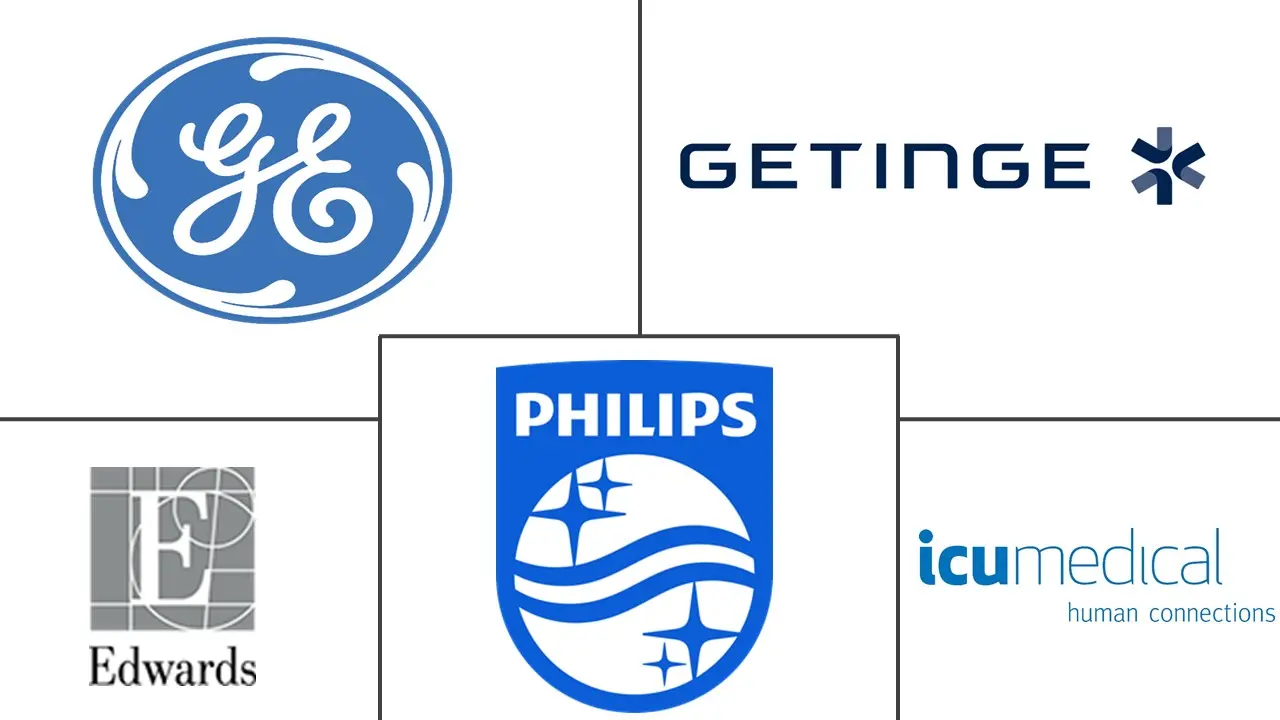Market Size of South America Hemodynamic Monitoring Industry

| Study Period | 2019 - 2029 |
| Base Year For Estimation | 2023 |
| Market Size (2024) | USD 72.71 Million |
| Market Size (2029) | USD 83.19 Million |
| CAGR (2024 - 2029) | 2.73 % |
| Market Concentration | Medium |
Major Players
*Disclaimer: Major Players sorted in no particular order |
South America Hemodynamic Monitoring Market Analysis
The South America Hemodynamic Monitoring Market size is estimated at USD 72.71 million in 2024, and is expected to reach USD 83.19 million by 2029, growing at a CAGR of 2.73% during the forecast period (2024-2029).
The outbreak of the COVID-19 pandemic has pushed the healthcare industry into action. Initially, the pandemic imposed an adverse effect on the market in South America America. For instance, as per the study published by the National Library of Medicine in April 2022, COVID-19 led to a significant decrease in cardiac diagnostic procedures in South America, mainly due to social distancing. It also stated that the pandemic had disrupted care delivery for cardiovascular diseases in South America. Similarly, as per the study published by the Journal of the American College of Cardiology, in January 2021, globally, cardiac diagnostic procedure volumes decreased by 42.0% from March 2019 to March 2020 and by 64.0% from March 2019 to April 2020 with the greatest decrease in South America. Therefore, such instances indicate that the market witnessed slow growth during the pandemic. However, the sector has been recovering well since restrictions were lifted, leading to increased cardiac procedures, thereby witnessing significant growth.
The key factors propelling the growth of this market are an increase in the number of critically ill geriatric cases, a rise in the prevalence of cardiac disorders and diabetes, increasing demand for home-based and non-invasive monitoring systems, and an increase in the number of people suffering from hypertension. For instance, according to the study published by Clànica e Investigación en Arteriosclerosis, in August 2021, the prevalence of risk factors for cardiovascular diseases among the South American population was relatively high in 2021. It also reported that the prevalence of high-risk scores for cardiovascular diseases and diabetes mellitus was high and healthy lifestyle habits were low in 2021.
Furthermore, as per the study published by the National Library of Medicine, in February 2021, in South America, hypertension, prediabetes, and type 2 diabetes mellitus prevalence range varies from 30.0% to 50.0%, 6.0% to 14.0%, and 8.0% to 13.0% respectively in the year 2021. It also reported that the proportion of awareness, treatment, and control of hypertension was deficient in Latin America. All these conditions are associated with an increased risk of cardiovascular diseases owing to which such instances are anticipated to propel the cases of cardiovascular diseases. Since hemodynamic monitoring devices are one of the essential requirements for monitoring of cardiac activity, therefore, significant market growth is expected over the forecast period.
However, increasing complications associated with invasive monitoring systems are the major factors restraining the market growth.
South America Hemodynamic Monitoring Industry Segmentation
As per the scope of the report, critically ill patients require continuous monitoring of their vital parameters. This is done by direct pressure monitoring systems, which are also known as hemodynamic systems. The main function of these systems is to monitor cardiac activity. The hemodynamic systems give information about blood pressure, blood volume, and fluid balance. The South America Hemodynamic Monitoring Market is Segmented by System (Minimally Invasive Monitoring Systems, Invasive Monitoring Systems, and Non-invasive Monitoring Systems), Application (Laboratory-based Monitoring Systems, Home-based Monitoring Systems, Hospital-based Monitoring Systems), and Geography (Brazil, Argentina, and Rest of South America). The report offers the value (USD million) for the above segments.
| By System | |
| Minimally Invasive Monitoring Systems | |
| Invasive Monitoring Systems | |
| Non-invasive Monitoring Systems |
| By Application | |
| Laboratory-based Monitoring Systems | |
| Home-based Monitoring Systems | |
| Hospital-based Monitoring Systems |
| Geography | |
| Brazil | |
| Argentina | |
| Rest of South America |
South America Hemodynamic Monitoring Market Size Summary
The South American hemodynamic monitoring market is poised for growth, driven by an increasing prevalence of cardiovascular diseases, diabetes, and hypertension among the population. The market experienced a slowdown during the COVID-19 pandemic due to disruptions in cardiac diagnostic procedures, but has since shown resilience and recovery as restrictions were lifted. Key factors contributing to market expansion include the rising number of critically ill geriatric cases, the demand for home-based and non-invasive monitoring systems, and the growing incidence of cardiac disorders. Non-invasive monitoring systems, such as electrocardiograms and pulse oximetry, are gaining traction due to their ability to mitigate complications associated with invasive methods. The regulatory framework in countries like Brazil is also expected to enhance the availability and adoption of these systems, further propelling market growth.
Brazil stands out as a significant contributor to the market, attributed to its high prevalence of cardiovascular diseases and associated risk factors like diabetes and hypertension. The increasing number of adults diagnosed with hypertension and the substantial impact of cardiovascular diseases on public health underscore the demand for hemodynamic monitoring devices in the region. The competitive landscape is moderately concentrated, with global and regional players like Getinge Group, Koninklijke Philips NV, Edwards Lifesciences Corporation, and GE Healthcare actively participating in the market. Recent advancements, such as Royal Philips' expansion of its ultrasound portfolio and Noninvasix's breakthrough device designation, highlight the ongoing innovation and strategic developments within the industry. These factors collectively indicate a promising growth trajectory for the South American hemodynamic monitoring market over the forecast period.
South America Hemodynamic Monitoring Market Size - Table of Contents
-
1. MARKET DYNAMICS
-
1.1 Market Overview
-
1.2 Market Drivers
-
1.2.1 Increasing Geriatric Population and Rise in the Prevalence of Cardiac Disorders and Diabetes
-
1.2.2 Increasing Demand for Home-based and Non-invasive Monitoring Systems
-
1.2.3 Increasing Number of People Suffering from Hypertension
-
-
1.3 Market Restraints
-
1.3.1 Increasing Incidences of Complications Associated with Invasive Monitoring Systems
-
-
1.4 Porter's Five Force Analysis
-
1.4.1 Threat of New Entrants
-
1.4.2 Bargaining Power of Buyers/Consumers
-
1.4.3 Bargaining Power of Suppliers
-
1.4.4 Threat of Substitute Products
-
1.4.5 Intensity of Competitive Rivalry
-
-
-
2. MARKET SEGMENTATION (Market Size by Value - USD million)
-
2.1 By System
-
2.1.1 Minimally Invasive Monitoring Systems
-
2.1.2 Invasive Monitoring Systems
-
2.1.3 Non-invasive Monitoring Systems
-
-
2.2 By Application
-
2.2.1 Laboratory-based Monitoring Systems
-
2.2.2 Home-based Monitoring Systems
-
2.2.3 Hospital-based Monitoring Systems
-
-
2.3 Geography
-
2.3.1 Brazil
-
2.3.2 Argentina
-
2.3.3 Rest of South America
-
-
South America Hemodynamic Monitoring Market Size FAQs
How big is the South America Hemodynamic Monitoring Market?
The South America Hemodynamic Monitoring Market size is expected to reach USD 72.71 million in 2024 and grow at a CAGR of 2.73% to reach USD 83.19 million by 2029.
What is the current South America Hemodynamic Monitoring Market size?
In 2024, the South America Hemodynamic Monitoring Market size is expected to reach USD 72.71 million.

